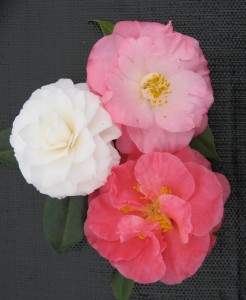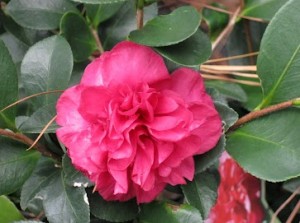Are you looking for an evergreen shrub with showy flowers in the fall or winter? Look no further than an old Southern favorite, the camellia.
Large camellias dot landscapes of historic homes throughout the Florida Panhandle, and although they look like they’ve been here forever camellias are not native to North America, but were originally brought here from Asia in 1797. There are many different types, but the most common camellias found in Florida are Camellia sasanqua which bloom in the fall (October – December) and Camellia japonica with larger leaves and a later bloom time of January through March. Some other types of camellias are Camellia reticulata, C. hiemalis, C. vernails and their hybrids; and Camellia sinensis is the source of tea which is made from the young leaves of this plant.
Flower colors range from a crisp white to a deep crimson and there are even some cultivars with variegated flowers! There are six recognized flower forms and they are single, semi-double, anemone, peony, formal double, and rose form double. Although most camellias have the potential to get over ten feet tall and five feet wide, there are some that grow slower and can be maintained at lower heights. Camellia sasanqua ‘Bonanza’ and C. sasanqua ‘Shishi Gashira’ have more horizontal branching habits and can be kept under five feet tall, however they will need more width than a more upright growing camellia.
When choosing a site for your camellia, look for an area with light shade, good air flow, and well-drained soil. Test your soil to determine pH and fertilizer needs before planting; soil testing kits can be picked up at your local county extension office. Camellias prefer acidic soil with a target pH range of 5.0 to 6.5, and benefit from organic matter amendments in sandy soil. Plant camellias slightly higher than the natural grade; dig a hole that is wide and shallow. After planting check that the top of the root ball is one to two inches above the soil line to allow for some settling. Mulching helps to conserve moisture and regulate soil temperatures, but be careful not to cover the root ball with thick mulch layers.
For more information about camellias and their care in Florida, please see Camellias at a Glance at http://edis.ifas.ufl.edu/pdffiles/EP/EP00200.pdf .
- Thinking of Starting a Cut Flower Business? Don’t miss out on Cut Flower 101! - October 30, 2025
- 2025 Gardening in the Panhandle LIVE! Great Southeast Pollinator Census – Bee a Citizen Scientist! Wrap Up - September 18, 2025
- Will you Bee a Citizen Scientist? - August 15, 2025


